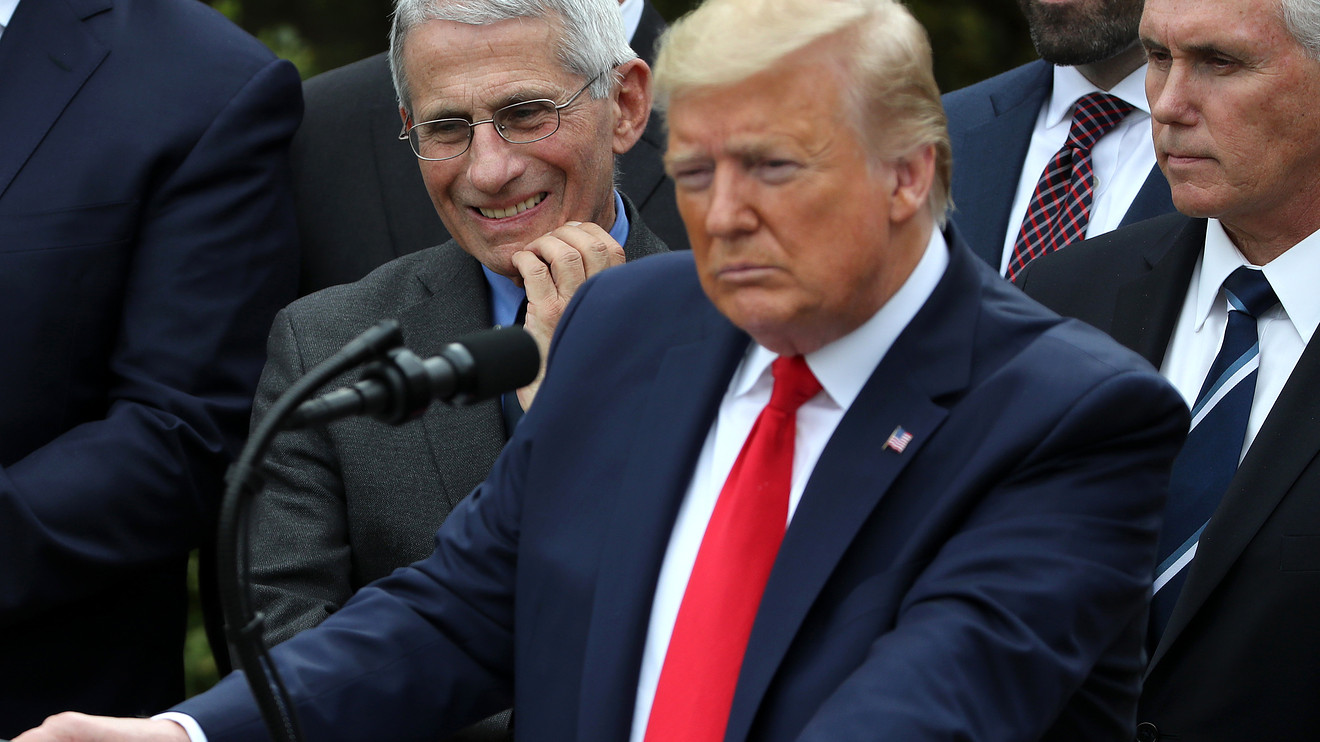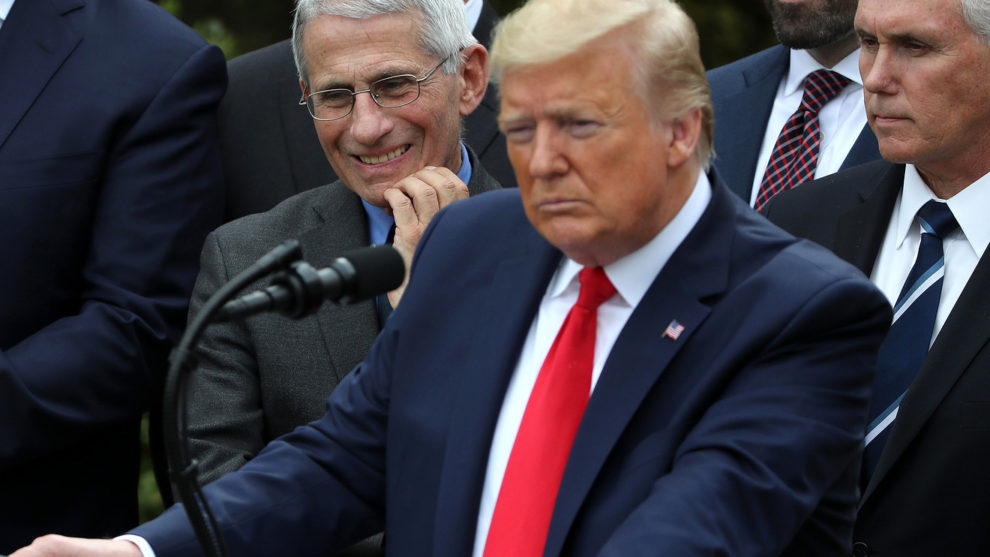
U.S. stocks booked their biggest daily gains since Oct. 28, 2008, after President Trump declared a national emergency to combat the coronavirus epidemic, a day after the Dow and the S&P 500 index suffered their biggest one-day plunge since the October 1987 crash.
The national emergency declaration unleashes $50 billion of funds to help contain the COVID-19 pandemic, but financial market conditions are expected to remain volatile in the wake of this week’s global market carnage.
How did markets fare?
The Dow Jones Industrial Average DJIA, +9.36% soared 1,985 points, or 9.4%, to settle at 26,79.16, while the S&P 500 index SPX, +9.29% rose 230.38 points, or 9.3%, to close at 2,711.02. The Nasdaq Composite Index COMP, +9.35% gained 673.07 points, or 9.4%, to end at 7,874.88.
On Thursday, the Dow and S&P 500 suffered their worst day since the “Black Monday” crash of Oct. 19, 1987. The Dow plunged 2,352.60 points, or 10%, to end at 21,200.62. The S&P 500 shed 9.5%, or 260.74 points, to close at 2,480.64. The Nasdaq tumbled 9.4%, or 750.25 points, to finish at 7,201.80.
The last time the S&P 500 had back-to-back 9% moves in October 1929 and the last time the Dow had back to back 9% moves was on Feb. 13, 1932.
For the week, the Dow was down 10.4%, the S&P 500 index booked an 8.8% decline, while the Nasdaq saw an 8.2% weekly plunge.
What drove markets?
President Trump declared a national emergency Friday afternoon, opening up a $50 billion spigot of funding to combat the coronavirus pandemic, while ramping up testing and expanding the ability of hospitals and doctors to provide treatments for the disease.
“This will pass through and we will be even stronger for it,” Trump said in an afternoon White House press conference, flanked by heads of top U.S. retailers and pharmaceutical providers.
“I think they’ll pull out all the stops to prevent the economy from falling hard from this,” said Bruce Bittles, chief investment strategist at RW Baird &Co., in an interview with MarketWatch, following the declaration.
“I think there are a lot more fiscal measures you’ll see next week,” he said.
Trump also said interest payments will be waived on the government’s share of the near $1.6 trillion pile of student debt and quantities of strategic crude oil reserves will be bought at recently, sharply lower prices. “We are going to fill it right up to the top,” Trump said of the reserves.
See: Trump declares national emergency due to coronavirus, putting more aid in play
House Speaker Nancy Pelosi told Democrats after the bell Friday that she had reached a deal with the White House on a coronavirus relief package, with voting to pass the bill expected Friday evening. The infectious disease was first identified in Wuhan, China, in December and has infected about 128,000 people world-wide.
U.S. Treasury Secretary Steven Mnuchin on Friday also said the government would use all its tools to support financing market functioning, while the Federal Reserve said it would ramp up its monthly purchases of Treasury securities, an effort aimed at getting banks to extend credit to businesses and beyond.
“The Fed’s done two things. It’s offered $1.5 trillion in intermediate term loans to dealers, which don’t seem to be in much demand,” Guy LeBas, chief fixed-income strategist at Janney Montgomery Scott, told MarketWatch in an interview. “And the Fed accelerated its regular month Treasury purchases.”
Meanwhile, the Bank of Canada made an emergency 50 basis points cut Friday to its benchmark rates to 0.75%, ahead of an expected announcement of a broad fiscal stimulus package for the nation, as its citizens were urged to postpone or cancel all nonessential travel outside the country in a bid to contain the pandemic.
Economists at JPMorgan & Chase Co. JPM, +18.01% said they now anticipate seeing a “novel” global recession driven by the pandemic, with two quarters in a row of negative growth, but didn’t expect an official downturn to be declared.
Yet, credit investors were cautious, waiting on further direction from the government on what additional relief it might offer to industries and markets upended by the outbreak.
“I think folks are, if they don’t have to sell, they’re not going to sell into this weakness,” said Jim Gubitosi, co-chief investment officer at Income Research + Management in Boston, in an interview with MarketWatch. “The general thought is we’re going to be in a tough stretch for a while, but hopefully at the end, there will be a far amount of monetary and fiscal stimulus that kicks in at some point.”
Stocks had plunged Thursday as liquidity fears joined the coronavirus pandemic and its effect on the economy in rattling investors.
Which companies were in focus?
Airline stocks rose, with Delta Air Lines DAL, +13.79% gaining 4.7% after the carrier said it would cut capacity by 40% and cancel flights to Europe. United Airlines UAL, +12.30% shares rose 4.6%. American Airlines AAL, +6.39% gained 6.4%.
Oracle Corp. ORCL, +20.43% earnings reported late Thursday showed the best revenue growth in nearly two years. Shares jumped 20.4%.
Shares of Norwegian Cruise Line NCLH, +15.03% gained 15% after it suspended cruises through April 11.
What did other markets fare?
Markets in Asia fell sharply on Friday. Japan’s Nikkei NIK, -6.08% fell 6.1%, while South Korea’s Kospi 180721, -3.43% lost 3.4%, each recording their worst weekly losses since October 2008, according to Dow Jones Market Data. London stocks bounced Friday, but saw the worst weekly performance since the 2008 crisis.
Oil futures finished slightly higher Friday, after a brutal week. West Texas Intermediate crude for April delivery CLJ20, +4.67% ending up 0.7% to settle at $31.73 a barrel, but booked a massive 23% loss for the week.
Gold futures came under further pressure Friday, potentially as investors sell what they can to cover losses. April gold GCJ20, -0.87% shed $73.60, or 4.6%, to settle at $1,516.70 an ounce Friday, while prices for the most-active contract lost 9.3% for the week, according to FactSet data.
div > iframe { width: 100% !important; min-width: 300px; max-width: 800px; } ]]>






